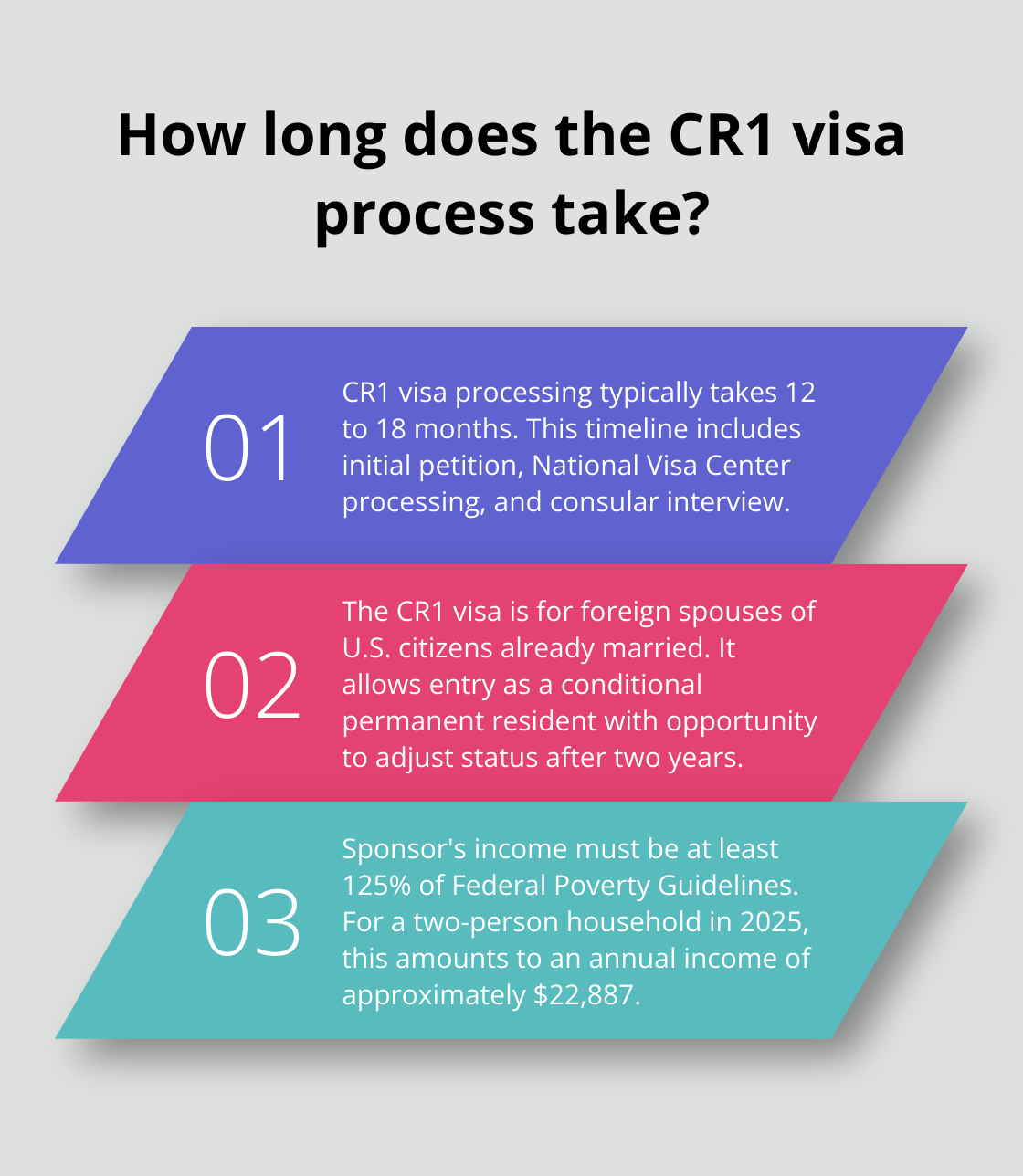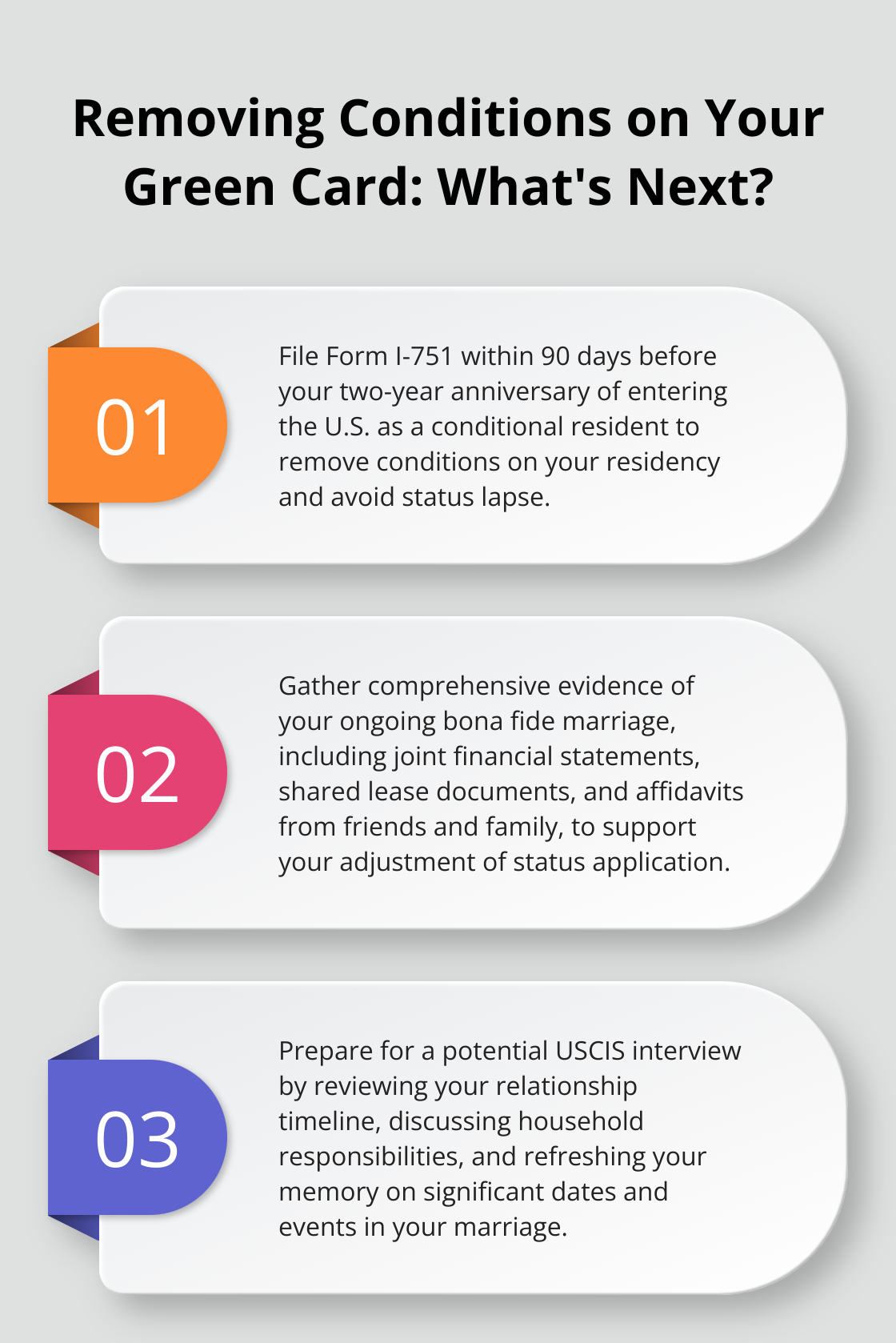
CR1 Visa: Adjusting Status After Marriage
Navigating the CR1 visa process and subsequent adjustment of status can be complex for married couples seeking to reunite in the United States.
At Law Offices of Jeffrey A. Thompson, we understand the challenges and emotions involved in this journey.
This guide will walk you through the CR1 visa application process and the steps for CR1 adjustment of status after arrival, providing clarity and practical advice for a smoother transition to permanent residency.
What is a CR1 Visa?
The CR1 visa (Conditional Resident visa) provides a path for foreign spouses of U.S. citizens to enter and live in the United States. This visa allows the spouse to enter the U.S. as a conditional permanent resident, with the opportunity to adjust their status to that of a lawful permanent resident after two years.
Eligibility and Requirements
To qualify for a CR1 visa, applicants must be legally married to a U.S. citizen. The marriage must be valid and recognized by U.S. law (including same-sex marriages). Both spouses must be free to marry, which means any previous marriages must have ended legally.

The U.S. citizen spouse must meet specific income requirements to sponsor their foreign spouse. The U.S. Department of State requires the sponsor’s income to be at least 125% of the Federal Poverty Guidelines. For a two-person household in 2025, this amounts to an annual income of approximately $22,887.
CR1 vs. K1 Visa: Key Differences
The CR1 and K1 visas serve different purposes for foreign partners immigrating to the U.S. The K1 visa caters to fiancé(e)s who plan to marry within 90 days of entering the U.S. The CR1 visa, however, applies to couples who have already married.
A notable advantage of the CR1 visa is that holders can work immediately upon entering the U.S. K1 visa holders must apply for work authorization after arrival, which can take several months to process.
Processing Times and Considerations
The CR1 visa process typically takes longer than the K1 visa. Recent data from the U.S. Citizenship and Immigration Services (USCIS) indicates that the average processing time for a CR1 visa ranges from 12 to 18 months. This timeline includes the initial petition, National Visa Center processing, and the consular interview.
Thorough preparation and accurate documentation can streamline the CR1 visa process significantly. Couples who provide comprehensive evidence of their relationship’s authenticity often face fewer delays and requests for additional information.
Documentation and Evidence
Applicants for the CR1 visa must submit various documents to prove their eligibility. These include (but are not limited to):
- Valid passports
- Birth certificates
- Marriage certificate
- Police clearance certificates
- Financial documents (to prove the U.S. sponsor meets income requirements)
- Evidence of a bona fide marriage (e.g., joint bank accounts, shared lease agreements, photos together)
The strength and completeness of this documentation can impact the processing time and success of the application. As we move forward to discuss the CR1 Visa Application Process, understanding these requirements will prove invaluable for a smooth journey through the immigration system.
How Does the CR1 Visa Application Process Work?
The CR1 visa application process involves several critical steps that require careful attention to detail and thorough preparation. This chapter outlines the key stages of the process, providing insights to help couples navigate their journey towards reuniting in the United States.
Filing the I-130 Petition
The process starts when the U.S. citizen spouse files Form I-130, Petition for Alien Relative, with U.S. Citizenship and Immigration Services (USCIS). This form establishes the relationship between the U.S. citizen and their foreign spouse. Historical USCIS data shows the processing times for Form I-130 from Fiscal Year 2020 to 2025 (up to January 31, 2025).

When you submit the I-130, include substantial evidence of your relationship’s authenticity. This may include:
- Joint financial records
- Shared lease agreements
- Photographs documenting your life together
The more comprehensive your evidence, the smoother the process tends to be.
National Visa Center Processing
After USCIS approves the I-130 petition, they forward the case to the National Visa Center (NVC). The NVC then contacts the applicant to collect additional documents and fees. This stage typically takes 3-5 months but can move faster if you promptly submit all required materials.
Key documents for NVC processing include:
- DS-260 immigrant visa application
- Affidavit of Support (Form I-864)
- Civil documents (birth certificates, marriage certificate, police records)
- Financial evidence
All documents must be accurately translated into English if they’re in another language. Incomplete or inaccurate submissions can lead to significant delays.
Consular Interview and Medical Examination
The NVC schedules an interview at the U.S. embassy or consulate in your spouse’s home country after processing your case. Your spouse must undergo a medical examination with an embassy-approved physician before the interview.
The consular interview is a pivotal step. Your spouse should prepare to answer questions about your relationship and future plans in the U.S. Honesty and consistency are paramount. The consular officer will review all submitted documents and may request additional information if needed.
Entering the U.S. with a CR1 Visa
Upon approval, your spouse receives a CR1 visa valid for six months. They must enter the U.S. within this timeframe. Upon entry, your spouse becomes a conditional permanent resident, receiving a temporary Green Card valid for two years.
CR1 visa holders can enter the U.S. as immigrants. This visa is required for spouses and other relatives of U.S. sponsors.
The journey from filing the I-130 to entering the U.S. with a CR1 visa typically takes 12-18 months. While this process can be complex, proper preparation and expert guidance can significantly smooth the path. As we move forward to discuss the adjustment of status process, understanding these initial steps will prove invaluable for a seamless transition to permanent residency.
Navigating the Adjustment of Status Process
Initiating the Process
The adjustment of status process starts within 90 days of your two-year anniversary of entering the U.S. as a conditional resident. The U.S. Citizenship and Immigration Services (USCIS) advises applicants to file Form I-751, Petition to Remove Conditions on Residence, as early as possible within this 90-day window to prevent any status lapse.
Essential Documentation
The adjustment of status process demands meticulous documentation. You must provide evidence that your marriage remains bona fide and ongoing. This includes:
- Joint financial statements
- Shared lease or mortgage documents
- Birth certificates of children born to the marriage
- Affidavits from friends and family attesting to the authenticity of your relationship
- Photos and travel itineraries demonstrating your life together

USCIS examines these documents closely. USCIS provides data on applications and petitions received, approved, denied, pending, and processing times by quarter and fiscal year.
Green Card Interview Preparation
USCIS may request an interview to verify the information in your application (although not all I-751 petitions require one). If selected, both spouses must attend. The immigration officer will ask questions about your relationship, shared experiences, and future plans.
You should review your relationship timeline, discuss how you manage household responsibilities, and refresh your memory on significant dates and events in your marriage.
Transition to Permanent Residency
After USCIS approves your I-751 petition, you’ll receive a new 10-year green card, which officially removes the conditions on your residency. This process typically takes 12 to 18 months from the filing date, though processing times can vary.
You must maintain your status throughout this period. Avoid spending extended periods outside the U.S., as this could jeopardize your application. If you need to travel, consult with an immigration attorney about obtaining a travel document to protect your status.
The adjustment of status process involves complex legal procedures with significant implications for your future in the United States. While this guide provides an overview, each case has unique aspects that may require professional legal advice. Immigration attorneys (such as those at the Law Offices of Jeffrey A. Thompson) specialize in guiding clients through this intricate process, ensuring all requirements are met and maximizing the chances of a successful outcome.
Final Thoughts
The CR1 visa and subsequent CR1 adjustment of status process provide a structured path for foreign spouses of U.S. citizens to build their lives in America. This journey involves complex legal procedures and stringent documentation requirements, from the initial I-130 petition to the final removal of conditions on residency. The CR1 visa allows spouses to enter the U.S. as conditional permanent residents with immediate work authorization, offering a stable foundation for couples to establish their lives.

Professional legal guidance proves essential for navigating the intricacies of immigration law, including the CR1 adjustment of status process. An experienced immigration attorney can ensure correct form filing, advise on gathering compelling relationship evidence, and represent clients in dealings with USCIS and other government agencies. These professionals understand the emotional and legal challenges involved in reuniting families across borders.
Law Offices of Jeffrey A. Thompson specializes in guiding couples through the complexities of immigration law. Our team provides personalized representation, leveraging expertise to navigate potential pitfalls and maximize the chances of a successful outcome. We assist with initial paperwork, prepare clients for interviews, and address complications that may arise throughout the process.


